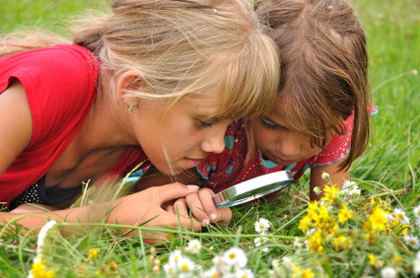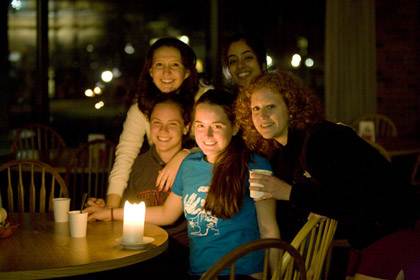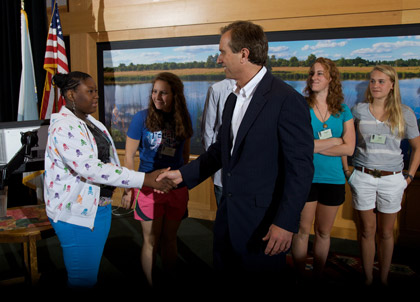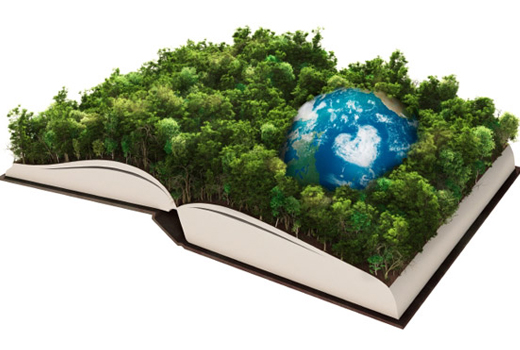Green Schools: A 21st Century Imperative
In a recent paper prepared for the upcoming Rio +20 Earth Summit, to be held in Rio de Janeiro June 2012, leading scientists issued a warning that humans are facing “an unprecedented [planetary] emergency” driven by overpopulation, overconsumption and use of environmentally damaging technologies. Climate change, biodiversity loss, resource depletion, environmental degradation, economic instability and a host of environmentally related illnesses will threaten civilization’s very survival if people do not act. Unfortunately, say the authors, “humanity’s behavior remains utterly inappropriate” for dealing with the problems people face, and their continued “failure to act will impoverish current and future generations.”
Indeed, the world’s children will be called upon to solve unimaginable challenges in their lifetime. They will desperately need the knowledge and tools necessary for survival in the 21st Century. According to Michael K. Stone in his book, Smart by Nature (2009), “This generation will require leaders and citizens who can think ecologically, understand the interconnectedness of human and natural systems and have the will, ability and courage to act.”
The need for global environmental education (EE), starting with the very youngest children, is urgent. In the United States alone, more than 130,000 public, private and independent K-12 schools educate approximately 55 million students each day. As keepers of the world’s most precious resource – its future leaders and problem solvers – schools have an obligation to prepare the next generation for the environmental challenges of the coming decades. They must actively engage children in global efforts to conserve resources, mitigate climate change, reduce pollution and transition humanity into a clean energy economy.
The New Era of Green Schools
In February 2012 at the Green Schools National Conference in Denver, Colo., U.S. Secretary of Education Arne Duncan expressed the view that green schools are no longer part of a fringe movement. EE is, in fact, necessary to meet the challenges of the 21st Century. Duncan, whose administration launched the Green Ribbon Schools Program, called for inclusion of EE in the reauthorization of the Elementary and Secondary Education Act. The U.S. Senate voted in favor of the change in 2011, thus marking the first time EE has been formally included in federal K-12 education policy. The Campaign for Environmental Literacy lists approximately one dozen states with requirements for EE in their K-12 curriculums. And, according to the North American Association for Environmental Education, some 47 states and the District of Columbia are in the process of developing new or revised Environmental Literacy Plans.

© iStockphoto.com/Madzia71
Despite growing support for EE by state and federal governments, and studies proving that EE improves academic performance across the curriculum, its prevalence in U.S. schools is far from universal. And, few states have legislative mandates for it. Numerous factors, including lack of funding and narrowly defined lesson plans, have hindered widespread EE integration into K-12 curriculums. Notwithstanding these realities, motivated teachers, students and parents have sought ways to incorporate environmental education activities into classrooms either as enrichment during school hours or after school. This includes starting environmental clubs and recycling programs, and participating in national conservation challenges. Through these channels, non-profit organizations have become increasingly involved with EE efforts in schools. The Green Schools Alliance (GSA) is one non-profit that has brought innovative environmental programs into K-12 schools within the U.S. and abroad.
The Green Schools Alliance
In response to Mayor Bloomberg’s challenge to New York City (NYC) institutions to reduce their carbon footprint 30 percent by 2030, on October 11, 2007, 46 schools gathered at the Allen-Stevenson School in NYC to explore solutions to climate change. After this meeting, with support from the Mayor’s Office of Long Term Planning and Sustainability, school associations, and numerous other partners, GSA was officially launched. Today it is a global network of schools guiding schools, which addresses 21st Century climate and conservation challenges. It includes more than 3,000 public, private and independent schools in 40 U.S. states and 12 countries, and represents more than two million students. GSA’s Student Advisory Board, comprised of high-school and college students, helps to steer its programs, mission and goals.
Membership in GSA is free and is built around a climate and sustainability “Leadership Commitment,” which asks schools to become either “GSA Climate Stewards” or “GSA Climate Champions.” GSA Climate Stewards are asked to benchmark their energy use and carbon footprint. GSA Climate Champions commit to reducing their carbon footprint by 30 percent in five years and to achieving carbon neutrality within 10 years. Both membership levels also ask schools to address all aspects of sustainability in addition to energy and emissions reductions. Entire public school districts may join at the Stewards level, as NYC and Chicago public school systems have done.
GSA goals are supported by national programs, including the Green Cup Challenge® and the Student Climate & Conservation Congress (Sc3). Both programs are open to member and non-member schools alike and involve faculty, students, business officers, facility managers and parent volunteers in a broad range of sustainability and energy actions.
The Green Cup Challenge®
The Green Cup Challenge® (GCC), launched 2007, is an annual month long inter-school energy challenge that takes place each January/February to call attention to peak winter energy use.

Photo Credit: Green Schools Alliance|Lawrenceville School in NJ hosts candle-lit “Lunches and Dinners in the Dark” during 2008 Green Cup Challenge.
Originally designed to help schools measure and reduce electricity use and greenhouse gas emissions, GCC provides hands-on learning opportunities for students and school staff, including facilities managers, to work together to reduce their school’s carbon footprint. GCC integrates education and action, quantifies progress and aggregates success.
Some of the activities students and staff undertake during GCC include: making videos, reading electric meters, collecting and aggregating data using spreadsheets, calculating average energy use and learning to use the Energy Star Portfolio Manager to establish a building’s baseline energy consumption. Students can view their own school’s results week-to-week and compare them with other schools’ data. Participation in GCC can greatly enhance a school’s science, technology, engineering and mathematics (STEM) curriculum. More importantly, GCC’s impact is real.
In the last five years, GCC participating schools have saved nearly six million kilowatt hours of electricity and prevented more than 3,500 metric tons (or 7.7 million pounds) of global warming carbon dioxide from being released into the atmosphere. During the 2012 GCC, some top performing schools managed to reduce energy use by more than 30 percent, thus showcasing the collective impact of hundreds of people performing simple actions like turning off lights in unoccupied spaces.
In April 2011, 20 participating GCC schools launched the first Green Cup “Recycle” Challenge to promote compliance with their recycling programs. The top three schools achieved recycling diversion rates of more than 80 percent. These program numbers demonstrate the enormous potential of a national school-based resource conservation movement. Lessons learned ripple outward from schools to families and workplace and endure long after GCCs are over.
Student Climate & Conservation Corps
In partnership with the U.S. Fish and Wildlife Service’s (FWS) premier training facility, the National Conservation Training Center (NCTC), GSA launched the Student Climate & Conservation Congress (Sc3) in 2009. Sc3 is GSA’s student arm and is open to 9th– through 12th-grade students who have demonstrated a commitment to environmental action. Selected Sc3 members, who are nominated by their schools, attend a five-day summer Congress held at NCTC in Shepherdstown, West Va. They enjoy a full program of study focused on the natural environment and 21st Century sustainability solutions.
The Congress includes substantial group discussions and lectures by world-renowned guests. Recent Sc3 speakers include: Robert F. Kennedy, Jr., oceanographer Sylvia Earle, authors Douglas Brinkley and Barry Lopez, 350.org founder Bill McKibben, Nobel laureate Virginia Burkett, PhD, and innovators, such as futurist Mitchell Joachim and founder of the LEED building rating system, Rob Watson.
The Congress trains students in leadership, conservation and sustainable design as well as topics like habitat restoration, education and fundraising. Using the building, campus or community as a teaching tool, students work alongside faculty and staff on a range of hands-on projects with environmental professionals, including cataloguing flora and fauna, and demonstrations on the installation of green energy technologies. Each day also includes time for outdoor programs, walkabouts, river hikes, campfire stories and stargazing, thus fostering an appreciation of the natural world, which the students are working hard to preserve.

Photo Credit: Lawrenceville School in New Jersey, USA|Sc3 student fellow shaking hands with Robert F. Kennedy, Jr.,
at GSA’s 2009 Student Climate & Conservation Congress.
Student Fellows learn the scientific, economic, political and social consequences of environmental inaction; they also learn about available opportunities to help them make a difference. They make a year-long commitment to action that is tracked by Sc3 faculty after the program ends. Sc3 Fellows return home with a new set of tools and a greater understanding of the interrelation between human societies, economies and the natural environment, thus making them an even stronger force for sustainable change in their local communities.
The results have been inspirational. Sc3 graduates have continued on to coordinate campus-wide greening initiatives, including installing green roofs, launching composting programs, conducting campus energy audits, building wetlands and working with school faculty to introduce curriculum on global warming and environmental justice.
Students Need Tools to Save Their Future
Driven by the concepts that individuals can make a difference and that schools can change the world, GSA has provided frameworks and ongoing support through its interactive website and social media sites. These help schools and school districts drive their sustainability initiatives forward. As Duncan commented in February 2012, “Your movement is helping not only to change the culture of our schools for the better but the culture of the Department of Education.”
GSA is actively collaborating with State Departments of Education across the U.S. and has found a steadfast partner in John Shea, chief executive officer, Division of School Facilities, NYC Department of Education. Shea recently said, “The Green Schools Alliance is an extraordinarily important part of our sustainability efforts here. As the largest school system in the U.S., with more than 1,200 buildings, my office had an overwhelming task in its effort to raise awareness about the importance of energy conservation, greenhouse gas reduction and operating buildings efficiently. Joining GSA was a strong first step in these efforts. Being a GSA member gave us great credibility among principals, administrators, facilities staff and, particularly, students, and made everyone feel they were part of a larger community. By benchmarking energy usage in all of our schools, we now have the data we need to engage each school community, as well as parents, elected officials and the City at large. GSA provides all our member schools with resources to help them reach their energy conservation goals and to help us all learn and grow.”
To be sure, no individual school or subset of schools can solve 21st Century environmental and climate challenges alone. GSA programs demonstrate the power of collaboration and collective action. The potential of a youth-led, inter-generational green schools movement to change the world for the better must be tapped. Young people know about climate change, pollution and habitat loss, and they want to save their future. Given the “unprecedented emergency” leading scientists say the world is facing, students must have all available tools at their disposal to help them do so.





























